Looking for an all-around belt knife that is also a workhorse?
Check out this classic pattern made with the latest materials.
by Leon Pantenburg
Improving on this classic design is really, really tough. Recently, the knife was upgraded with a Magna-Cut steel blade. Order yours here.
All it takes (for me to acquire yet another knife I don’t need) is a historic, classic pattern made with new, improved steel. Such knives hit me squarely in the wallet.
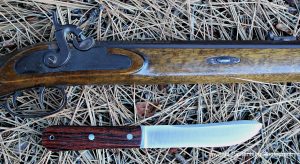
This replica of a Hawken rifle and the Mountain Man knife fit together really well.
That’s what happened with the new Mountain Man knife from Bark River. Bark River Knives originally made the Mountain Man in 1095 carbon steel and then again in A-2.
This batch, according to The KnivesShipFree website, should out-perform the older models by a very wide margin. Bark River Knives has used CPM-3V in a very thin cross section – just like the original thickness of the knife.
Specs:
- Overall Length: 9.875 Inches
- Blade Length: 5.5 Inches
- Blade Steel: CPM 3V @ 59-61
- Blade Thickness: .093 Inch
- Weight: 5.1oz
- Made in USA
This was the favorite belt knife of the American mountain man during the early to mid 1800s. Most were made by the Russell Company and some were branded “Green River”.
The mountain men used the name “Green River” as a standard of quality for anything traded. Anything done “Up to Green River” signified first rate merchandise.
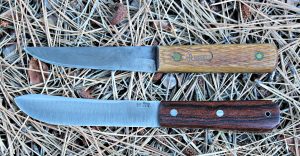
The Mountain Man, bottom, bears a strong resemblance to the replica Russell.
Green River knives were made in Greenfield, Massachusetts by J. Russell & Co. The factory was started in 1832-34 to make butcher and kitchen knives. Close to 60,000 Russell Green River knives per year were shipped to the West for several years. Among the most popular is the Green River Scalper, Skinner and variations used by the American mountain man then.
However, the J.Russell & Co. did not start stamping their products with “Green River Works” until some time in 1837. It is unlikely any were even available to be shipped to rendezvous until 1838 or later. The Green River Knife was a favorite of the emigrant, gold seeker, buffalo hunter, miner, Indian, and settler.
The BR Mountain Man is really a medium size butcher knife. I’ve used a similar Russell replica for years. The design is solid, no-nonsense and just flat works.
Here’s the good stuff about the Mountain Man:
Size: A 5.5-inch blade is about perfect for butchering and skinning. It’s also going to make a great kitchen knife, and it will be handy around camp for preparing food and just about anything else you need a knife for.
Blade thickness: Finally, a working knife with a practical blade thickness!
There seems to be different schools of blade thickness thought when it comes to knives.
Thick blades are sturdier, of course. But they don’t slice as well, and IMO are unnecessarily heavy and unwieldy. Check out real swords and daggers at a museum sometime – most of them are pretty thin.
The original mountain man Russells and other trade knives were designed by popularity and sales records. They were user, working tools designed to sell. Apparently, the Natives and trappers preferred thin blades, or someone would have made a thick blade knife to compete with the Russells.
I prefer a thinner blade. After several decades of big game hunting, fishing, backpacking, canoeing and hiking, I’ve never broken a blade in the field. With today’s super steels, I think the thick blades are best confined to out-and-out survival/tactical/fighting knives.
Handle: The original Russells were frequently sold without a handle, and the buyer put on his own. These handles were probably bone, antler or wood, depending on what was available.
My Mountain Man came with a stabilized cabolo wood handle, because it looks cool and the knife will blend in with my kitchen knife rack. I find that the stabilized wood and micarta become “grippier” when wet, making for a more secure and safe handle.
I have large hands, and the 4.3-inch handle fits me well. I used the Mountain Man to whittle some pine, cut vegetables and meat and carve a cooked turkey. Even with fat on the handle, the knife was safe to use.
Tip: The point has an upswept grind with a drop point. This is classic butcher knife design, and it’s clear this knife was originally designed to field dress and skin big animals. It will work well for hunters.
Spine: The edge opposite the sharpened edge is ground at 90-degrees, like an ice skate. This means it could be used to scrape a ferrocerrium rod to generate sparks for firemaking or processing tinder. This can come in handy.
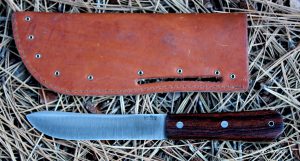
The Mountain Man needs a traditional sheath like this replica.
Steel: Here’s the best part – CPM 3V is a super steel, and one of my favorites for a working knife. It resists staining well, and hold an edge like crazy. Practice your honing, and the blade will always be razor sharp.
The latest version comes in Magna-Cut steel. I have been using knives in that steel since it came out, and the steel performs really, really well. This latest incarnation may be the best yet.
Sheath: The Mountain Man comes with a sturdy leather sheath that will protect and secure the blade well. But the knife cries out for a traditional leather sheath appropriate for the fur trade era. I have one, and that’s what the mountain man will ride in.
Made in the USA: All Bark River knives are made in Escanoba, Michigan, by American craftsmen. The knives have one of the best warranties on the market, a 100 percent satisfaction guarantee. These folks pay taxes and support their communities. Let’s support American small business!
In the wake of Leonardo DiCaprio getting an Oscar for his work in The Revanent” I predict renewed interest in the western fur trade era. I was hooked by Charlton Heston in “The Mountain Men” back in 1980, and never quite got over it.
I predict this knife is going to do very well among fur trade aficionados, or anyone who is looking for a practical, usable camp knife.
The Mountain Man is “Up to Green River.”
Please subscribe to the Survival Common Sense website
And the Youtube channel
You can also order my book “Bushcraft Basics: A Common Sense Wilderness Survival Handbook” at your local independent book store:
or on Amazon
or at Barnes and Noble
or at Books a Million

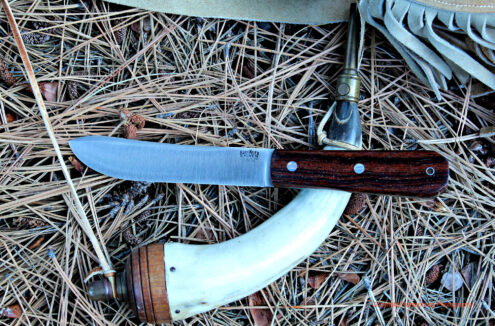
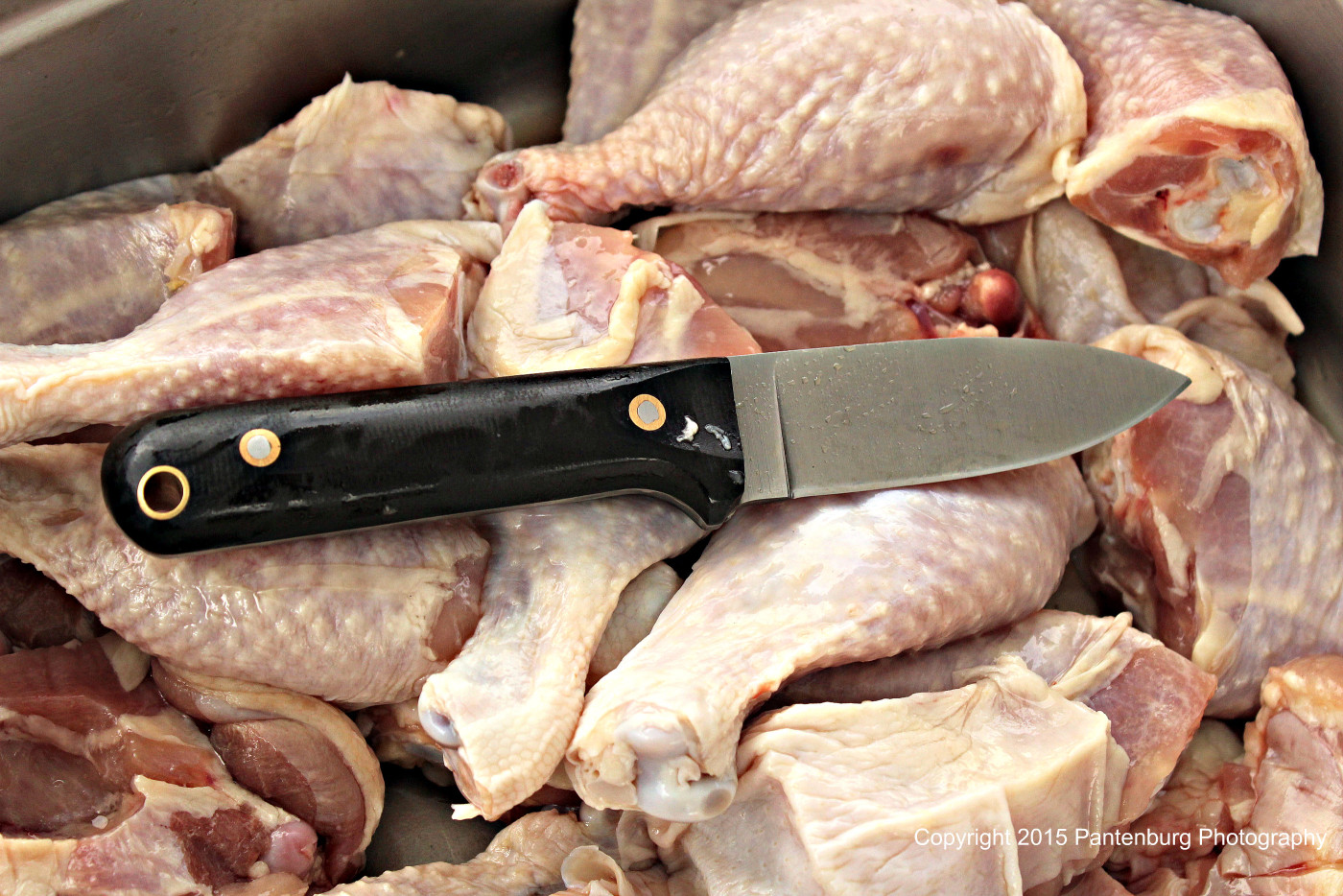
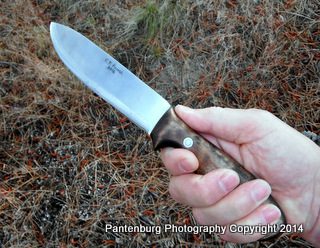

Leon
Thanks for the feedback – I love discussing history with fellow history nerds!
Here is what I wrote: This was the favorite belt knife of the American mountain man during the early to mid 1800s. Most were made by the Russell Company and some were branded “Green River”.
The mountain men used the name “Green River” as a standard of quality for anything traded. Anything done “Up to Green River” signified first rate merchandise.
Green River knives were made in Greenfield, Massachusetts by J. Russell & Co. The factory was started in 1832-34 to make butcher and kitchen knives. Close to 60,000 Russell Green River knives per year were shipped to the West for several years. Among the most popular is the Green River Scalper, Skinner and variations used by the American mountain man then.
However, the J.Russell & Co. did not start stamping their products with “Green River Works” until some time in 1837. It is unlikely any were even available to be shipped to rendezvous until 1838 or later. The Green River Knife was a favorite of the emigrant, gold seeker, buffalo hunter, miner, Indian, and settler.